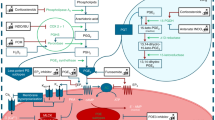Abstract
The fetal patency and neonatal closure of the ductus arteriosus (DA) are regulated with oxygen and prostaglandins. The proposed oxygen sensors of fetal and neonatal DA include P450-endothelin and the Kv channel [1]. We hypothesized that the ATP-sensitive potassium channel (KATP channel) is another oxygen sensor [2].
You have full access to this open access chapter, Download chapter PDF
Similar content being viewed by others
Keywords
The fetal patency and neonatal closure of the ductus arteriosus (DA) are regulated with oxygen and prostaglandins. The proposed oxygen sensors of fetal and neonatal DA include P450-endothelin and the Kv channel [1]. We hypothesized that the ATP- sensitive potassium channel (KATP channel) is another oxygen sensor [2].
Fetal and neonatal DA was studied with Wistar rats; sulfonylurea drugs including tolbutamide, chlorpropamide, gliclazide, glimepiride, and glibenclamide (KATP channel inhibitors); diazoxide and pinacidil (KATP channel openers, KCOs); and rapid whole-body freezing (Fig. 37.1).
The fetal ductus arteriosus was studied in the near-term fetus or newborn rat following rapid whole-body freezing, cutting on the freezing microtome, with a microscope and a micrometer. The control fetus shows a widely open ductus (a), and the fetus with glibenclamide (10 mg/kg; 10–100 times clinical dose injected at 1 h before) shows severely constricted ductus (b). AA aortic arch, DA ductus arteriosus, LA left atrium, LPA left pulmonary artery, LSVC left superior vena cava, RPA right pulmonary artery, T thymus
Tolbutamide, chlorpropamide, and gliclazide easily passed across the placenta and constricted fetal DA dose-dependently following orogastric administration to near-term pregnant rats. The fetal DA constricted 30 % with clinical doses of sulfonylurea drugs and closed completely with larger doses.
Glimepiride and glibenclamide passed across the placenta minimally and only mildly constricted the fetal DA after maternal administration, but constricted and closed the fetal DA dose-dependently with direct fetal injection. Fetal DA closure was associated with hydrops and fetal death.
Diazoxide and pinacidil delayed DA closure following neonatal injection immediately postnatally and dilated the closing DA with injection at 60 min postnatally.
All tested sulfonylurea drugs constricted fetal DA dose-dependently and with complete closure at large doses. KCOs dilated the neonatal DA. These results indicate physiological regulation of fetal and neonatal DA with KATP channels.
This study has several clinical implications. Sulfonylurea-associated fetal death was first reported 50 years ago. The mechanism of death remained unclear prior to this study. Sulfonylureas may be useful for closing patent DA in premature neonates.
Recently reported neonatal DA reopening associated with the use of diazoxide for hyperinsulinemic hypoglycemia has been proved experimentally. DA-dilating effect of KCO drugs may be useful as a bridge to surgery in neonatal DA-dependent congenital heart diseases.
References
Coceani F, Baragatti B. Mechanisms for ductus arteriosus closure. Semin Perinatol. 2012;36:92–7.
Nakanishi T, Gu H, Momma K, et al. Mechanisms of oxygen-induced contraction of ductus arteriosus isolated from the fetal rabbit. Circ Res. 1993;72:1218–23.
Author information
Authors and Affiliations
Corresponding author
Editor information
Editors and Affiliations
Rights and permissions
Open Access This chapter is distributed under the terms of the Creative Commons Attribution-Noncommercial 2.5 License (http://creativecommons.org/licenses/by-nc/2.5/), which permits any noncommercial use, distribution, and reproduction in any medium, provided the original author(s) and source are credited. The images or other third party material in this chapter are included in the work's Creative Commons license, unless indicated otherwise in the credit line; if such material is not included in the work's Creative Commons license and the respective action is not permitted by statutory regulation, users will need to obtain permission from the license holder to duplicate, adapt or reproduce the material.
Copyright information
© 2016 The Author(s)
About this chapter
Cite this chapter
Momma, K., Monma, M., Toyoshima, K., Hayama, E., Nakanishi, T. (2016). Fetal and Neonatal Ductus Arteriosus Is Regulated with ATP-Sensitive Potassium Channel. In: Nakanishi, T., Markwald, R., Baldwin, H., Keller, B., Srivastava, D., Yamagishi, H. (eds) Etiology and Morphogenesis of Congenital Heart Disease. Springer, Tokyo. https://doi.org/10.1007/978-4-431-54628-3_37
Download citation
DOI: https://doi.org/10.1007/978-4-431-54628-3_37
Published:
Publisher Name: Springer, Tokyo
Print ISBN: 978-4-431-54627-6
Online ISBN: 978-4-431-54628-3
eBook Packages: MedicineMedicine (R0)




